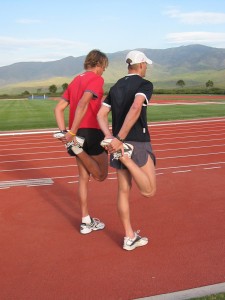To Stretch or not to Stretch?
Written by Physio Myles Burfield
As an athlete I have been part of sporting cultures in individual and team sports at amateur and elite levels. Like any athlete I suffered injuries and wanting a quick recovery I would eagerly listen to my learned coaches, family, friends, neighbours and anyone else who had an opinion (which is almost everyone). I found many inconsistencies in peoples understanding of injury management and prevention, and I was left totally perplexed. Do I stretch before or after training? What’s more important; stretching, warm-up or cool down? Will stretching stop a re-injury etc etc. And these are important questions because let’s be honest, nobody wants to stretch. If you give me a choice between an hour run, and a 40minute run with 20minutes of pain to follow as I try to snap my hamstring in half, I’m going to choose to Forrest Gump and keep on running.
 Now all grown up and working as a Physiotherapist I have realised that unfortunately our use of stretching as a prevention against sports injury has been based on intuition and unsystematic observation rather than scientific evidence. So let’s have a look at some of the facts and fiction being presented to us from the recent research.
Now all grown up and working as a Physiotherapist I have realised that unfortunately our use of stretching as a prevention against sports injury has been based on intuition and unsystematic observation rather than scientific evidence. So let’s have a look at some of the facts and fiction being presented to us from the recent research.
– Fact: Stretching increases muscle flexibility: Many studies have shown that stretching does increase available range of motion and decrease resistance to stretch. Stretching can give up to a 20% decrease in resistance to stretch. Although for these effects to last longer than 10minutes stretching had to be for at least 4minutes (4X60sec holds). The duration of increased flexibility after a single stretching session ranged for 60-90minutes.
– Fact: Longer stretches give better effect. With stretching less than 2minutes (4X30sec holds) effects were completely lost after 10minutes of rest. So if you’re going to stretch for 1minute then stuff around while you make a playlist of your favourite songs on your ipod, don’t waste your time.

– Fact: You can increase your flexibility long term. Stretching programs have produced flexibility increases that carry over for several weeks.
– Fiction: Better flexibility means your muscles can stretch further and have less chance of injury. This is false, in fact most muscle strains occur during eccentric loading, (when muscles develop tension while they lengthen), within normal range of motion. For example straining your quadriceps when you land from a high jump. This is not an issue with muscle length; more likely contributing factors include muscle weakness, poor endurance, inappropriate training load or technique.
– Fiction: The more flexible I am the less my chances of injury. There have also been several military studies assessing the effect of pre-exercise stretching on overuse injuries and they found no clear benefits. In fact athletes who were ‘least flexible’ and ‘most flexible’ had the highest risk of injury. This suggests there are optimal levels of flexibility to enhance performance, and that these levels are sport specific.
– Fiction: There are no adverse effects of stretching. Studies have shown a decrease in performance, measuring vertical jump and sprint speeds, directly following a lower limb stretching protocol. Although there has been no link between stretching and an increased risk of injury. The good news is that the temporary strength deficits following stretching can be reversed by appropriate dynamic warm-up drills.
So how do these facts change how you do your stretching? Like with any of your training you need to think about what you are trying to achieve. There is no set stretching ‘best practice’ that can be set across the board for all athletes in all sports. No matter how much we all want to run like Tim Van Berkell , we are individuals and what works for one won’t work for everyone.

Firstly warm-up is critical. Warm up including dynamic resistance drills produces superior performance when compared to stretching alone. Speak to your Physiotherapist or coach about the best dynamic warm-up drills for your sport.
Secondly don’t spend your time stretching every muscle. “See our article on Who should Stretch and Why” and also consider a Musculoskeletal Screening with your Physio to determine which area’s you have flexibility/muscle control deficits that may be detrimental to performance”.
For your stretch to have a significant effect it needs to be over 4minutes long (4X60sec), so unless you intend to spend your morning stretching for your afternoon run, pick your trouble muscle groups and concentrate on them. Also stretch specific to your training and body type, if you’re running then spending a long time stretching your calves and quads will generally be more beneficial than doing pectoral stretches. If you are doing brick sessions going from bike to run, valuable minutes spent pre-stretching your quads and hip flexors will be wasted as these gains will be lost while you are pedalling away. Instead focus on your hamstrings and back so you can be comfortable down on the drops. Obviously if you are recovering from a particular injury then specific stretching for that injury pre-exercise is important.
Thirdly pre-exercise stretching is different to post exercise stretching or specific stretching programs. Stretching after exercise is important to restore resting muscle length. Tight muscles increase load through tendons and can lead to overuse injuries like tendonopathy and friction syndromes. Stretching programs do produce long term gains so just because pre-exercise stretching doesn’t decrease the risk of injury you shouldn’t forget it entirely. Use of foam rollers and spiky massage balls can be a great adjunct to static stretching alone and using them during rest times (when watching tv etc) can help give you longer term flexibility gain and keep you training.
